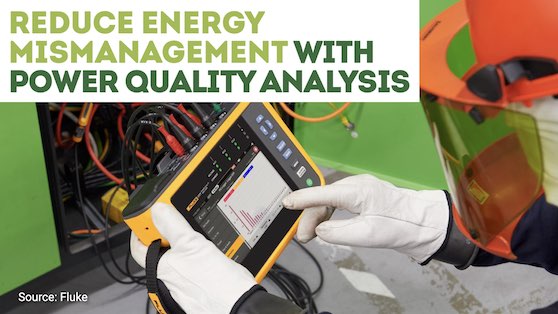
Articles
Features
Articles
Test & Measurement
Reduce energy mismanagement with power quality analysis
July 5, 2023 | By Jason Axelson

July 5, 2023 – No matter the industry in which you work, energy is a part of the how the work gets done, which is why uncovering wasted energy or energy savings opportunities in a facility can be like looking for a needle in a haystack.
That’s where power quality testing and analysis comes in. When you know where to seek out—and how to analyze—power quality data, you’re well on your way toward minimizing energy waste and/or saving energy cost.
Power quality studies
Before you can begin addressing issues, you need to conduct power quality studies in your facility. These studies will help highlight a lot of what you can do to save energy or reduce wasted energy throughout your plant.
Adding a power quality monitoring regimen to your preventive maintenance routine can also tip you off to emerging issues, allowing you to mitigate quickly so that your facility doesn’t waste even more energy.
Looking for energy mismanagement
The best way to start your search for energy waste is to identify when and where your energy is being used. Look at your utility bills, highlight any peak demand charges, and look at the rate schedule from the utility provider. Compare that to your own facility schedule to see when you’re using energy at different times of the day.
From there, you will map out your electrical supply system and look at the areas of your facility that tend to have the highest wasted energy usage, but with fairly easy-to-fix issues.
Electromechanical
Here are the five most common sources of energy waste in an electromechanical system.
1. Electrical. Electrical energy waste often presents in voltage overload, current overload, or phase imbalance. A power quality analyzer or thermal imager can detect these issues.
2. Scheduling. Using your PQ analyzer, log power consumption to catch one of the easiest energy savings solutions. Determine which machinery uses the most energy, and check whether you can adjust their operation align with the cheapest utility rates.
3. On/Off/Idle. Again, log power consumption to get a baseline of what assets are using power and when. If any machinery is drawing power while not being used, see if it can be turned off or idled.
4. Age and efficiency. Overhauling or replacing assets before they fail can often save money in the long run. It’s worth logging how much power older assets are using compared with their sizing and efficiency rating requirements. If they’re using more power than they should be, how long will it take a new motor to pay for itself? Sometimes it’s worth replacing early.
5. Mechanical/friction. Overheating and excess vibration can be signs of a motor or drive wasting energy due to a mechanical issue. Detect these issues using a thermal imaging camera or vibration meter.
And a few more to keep in mind…
Steam. Process heating can account for a large portion of operating costs, but it can also be controlled. Regularly inspect your system for failed steam traps, leaks, blockages, or failures. A thermal imager can help ensure as much preheated condensate returns to the boiler as possible.
Log energy consumption with a power quality analyzer at the boiler to get a baseline for what’s normal. Inspect the distribution system—including pressure gauges, insulation, pumps, valves, and steam traps—to catch wasted energy through steam and heat.
Compressed air/gas. Compressed air or gas leaks can waste a huge amount of energy as the system(s) struggles to maintain pressure. Identify and quantify the level of waste by logging power over a full business cycle at air compressors to establish how much energy it currently takes to produce air pressure levels.
Then go through your facility with a sonic industrial imager to find leaks. Once those have been repaired, you can rerun the power quality analyzer to see how much energy you’re saving.
How to spot energy waste
As you’re logging and pulling data across your facility, you need to know what kinds of measurements to monitor. Key areas that provide a insight into your power quality are: harmonics, voltage regulation, and unbalanced loads.
Harmonics. Signs of harmonics will show up in your power quality logging as distorted current or voltage. The ideal sine wave is not maintained. On your equipment, this may present as excess heat created in the conductors carrying the harmonics, resulting in overheating in phase and neutral conductors, cable runs, motor windings, and even transformers.
Voltage regulation. Issues with voltage regulation will show up as transient voltages and voltage imbalance on a power quality analyzer. Both issues can lead to unplanned downtime, asset failure, and even expensive repairs if not caught soon enough.
Unbalanced loads. Diagnose and measure voltage imbalance at a motor load with a power quality analyzer. Small amounts of voltage imbalance can lead to significant current imbalance. These issues come with an increased power cost and can lead to increased vibration, pulsations, and mechanical stresses on your machinery.
Continuous power quality monitoring
Power quality studies highlight a lot of what can be done to save energy, reduce energy losses due to issues throughout a facility, and lower energy costs. PQ monitoring can help identify where issues are coming from and how to fix them. From individual equipment data to all-up system health, power quality studies are a must for everyone responsible for uptime and energy efficiency.
Jason Axelson is a product application specialist for Fluke, a manufacturer of electrical test and measurement tools. He regularly conducts application training to help end users diagnose and resolve both technical and product enquiries.
You’ll find all Back Issues of Electrical Business Magazine in our Digital Archive.
Print this page
